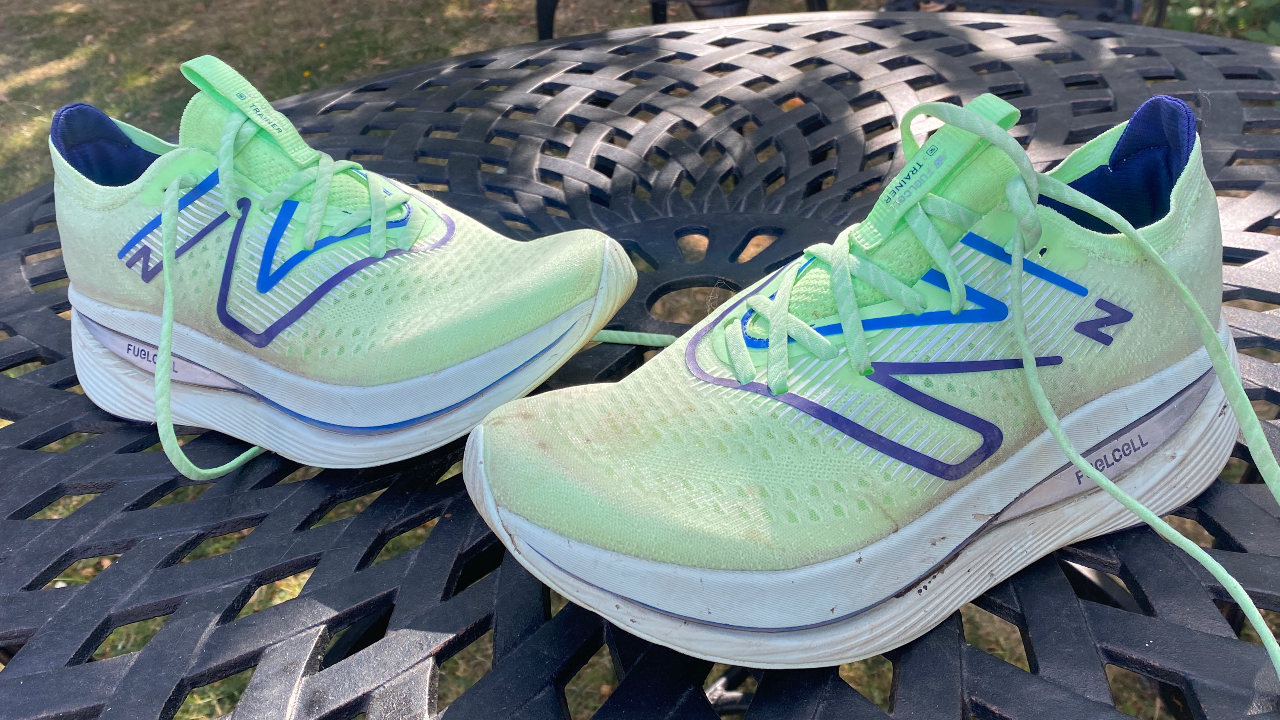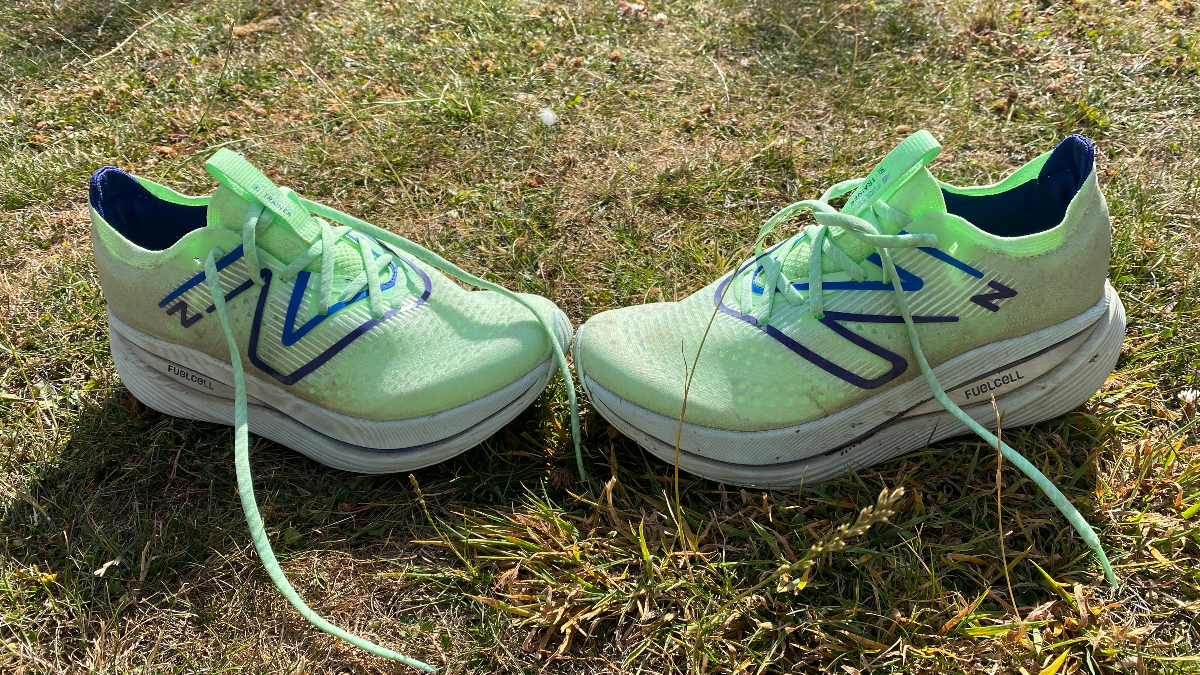Our Verdict
Its 47mm midsole stack and carbon plate make the SuperComp Trainer extraordinarily springy, though using such a big shoe has its drawbacks and the high price will rule it out for many runners.
For
- As bouncy as running shoes get
- Stable
- Versatile
Against
- Big and heavy
- Price is too high
- Wobbly on uneven ground
You can trust Coach
Adidas launched the first major shoe that proudly had a stack height of more than 40mm (the legal limit for road racing) with the Prime X. Others were always destined to follow, because having such a large amount of midsole foam paired with a plate can increase the benefits you get from the best carbon plate running shoes.
The New Balance FuelCell SuperComp Trainer is designed to be the ultimate training shoe, offering a huge amount of bounce to keep your legs fresh as you tackle easy and hard runs alike. It goes a long way towards delivering that. However, there are key drawbacks that mean it falls short of the best running shoes and the SuperComp Trainer’s outrageous price means you could easily pick up a more affordable legal super-shoe alternative to train with instead.
New Balance FuelCell SuperComp Trainer: Price And Availability
The SuperComp Trainer is available now and costs $180 in the US and £210 in the UK. The UK price is a bizarre conversion from the US one and it also means the SuperComp Trainer has the same RRP as the Nike Vaporfly NEXT% 2 and Saucony Endorphin Pro 3 – two of the best racing shoes on the market.
Design And Fit
The SuperComp Trainer has a stack height of 47mm at the heel and 39mm at the forefoot, giving it an 8mm drop. That huge midsole is made from New Balance’s FuelCell foam, which I rate as among the best on the market, because it delivers a soft-and-springy ride while being light.

At 10.8oz/307g in a UK size 9, the SuperComp is not a featherweight, but that’s lighter than I expected it to be given the high stack. The shoe also has a wide base in an attempt to increase stability, and raised side walls of foam at the top of the midsole cradle the foot again in a bid to ensure the high stack isn’t too unstable. There is a full-length carbon plate running through the midsole. This has a scooped shape and is placed quite high in the foam at the heel to give a firmer feel to your landings.
The shoe has a rocker design and a large midsole cut-out that runs down the centre of the midsole that reduces weight and guides your foot into the centre of the plate during your footstrike. It’s another stability-enhancing feature – and every one of them is needed with a stack this high.
Outside of the midsole, efforts have been made to keep the weight down with the thin upper that has limited padding on the tongue or around the collar. I found it comfortable on long runs and it held my foot securely. The shoe is slightly tight around the toes in my normal size, so there could be a case for going up half a size. I found it fine in my usual size 9, but I am generally in between an 8.5 and a 9.
The outsole has two strips of rubber on the forefoot and at the heel, framing the cavernous midsole cut-out. The rubber sits almost flush with the midsole and there is exposed foam in the middle, which could reduce durability, but I’ve seen no undue wear and tear after 71km in the shoe.

How I Tested This Shoe
I ran 71km in the New Balance SuperComp Trainer. This was a mix of my marathon training runs, including a track session and a 22-mile run.
Running Performance
After one run in the SuperComp Trainer I was convinced I was going to love it. To simply describe it as bouncy does it a disservice. It’s the bounciest shoe I’ve ever come across. Where other shoes will feel springy when you first step in, but lose that feeling over the course of a run, there is no bottoming out with the SuperComp. It feels the same from the first step to the last.
My first run was a fairly short and easy run and I had the Trainer pegged as the perfect long run shoe after that. Luckily enough, my next run was a 22-miler and I couldn’t wait to use it again. Over the course of that long run, however, I fell out of love with this shoe. After 10 miles the weight and size of the shoe started to tell and it felt awkward. The bigger problem was that I found it mentally draining to run in the shoe.
It’s not unstable, but I was aware of every step. By which I mean I wanted to make sure there was a good landing spot for the high stack of soft foam, and taking corners proved a bit wobbly at anything above easy pace.

By the end of the run I had the strange sensation of my legs being fairly fresh because of the protection the SuperComp Trainer offers, but overall I felt like I’d been dragging my feet through the last 12 miles of the run in a shoe I was far too aware of.
I had the same sensation on another easy run in the shoe, and while the ride does feel as I expected it to, the idea of using it for regular training doesn’t appeal. It is a versatile shoe, though, and when I took it to the track for 60-second reps at around 3min/km pace it felt lighter than it is. It’s only over longer reps and distances that I found it moved from being an enjoyable ride to being just a bit too much.
Is The New Balance SuperComp Trainer Worth It?
The New Balance SuperComp Trainer is the shoe I expected it to be. It’s bouncy, a bit hefty, but still versatile. What I didn’t expect was not to enjoy this kind of shoe very much for regular use. And, having expected it to be the ultimate long-easy or steady-run shoe, I wouldn’t be keen to lace it up for anything over 10 miles again.
It’s also too expensive, especially in the UK. For £210 you can get the Saucony Endorphin Pro 3 and use it as a daily trainer if you want to – it’s great for easy runs, while being one of the most impressive carbon plate racing shoes.
The best daily trainers I’ve come across are all much cheaper too. The Saucony Endorphin Speed 3 has a comfortable but speedy ride and is much lighter than the SuperComp Trainer. The Hoka Mach 5 doesn’t have a plate but feels more natural to run in and is smooth and efficient for long runs, while still being light and nippy for speedwork. There’s also the Puma Velocity Nitro 2, which has a soft, cushioned ride with enough spring in it for faster running.
If you are excited by the high stack and bounce on offer here then the SuperComp Trainer does deliver, even at a high price. I’d still urge caution, though, because I thought I’d enjoy the ride but quickly found the shoe overbearing.

Nick Harris-Fry is a journalist who has been covering health and fitness since 2015. Nick is an avid runner, covering 70-110km a week, which gives him ample opportunity to test a wide range of running shoes and running gear. He is also the chief tester for fitness trackers and running watches, treadmills and exercise bikes, and workout headphones.

